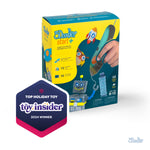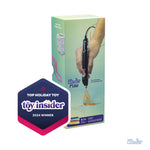Simple Machine Design Challenge (Forces and Motion)
In this activity, students work in pairs to brainstorm, design and create models of 6 different simple machines from our everyday world, e.g., see saw (lever), ramp (inclined plane), wagon (wheel and axle), jar lid (screw), axe (wedge), well (pulley). This activity gives students a concrete understanding of the design, engineering, mechanics and purpose of each simple machine.

KnowledgeStudents havelearned about simple machines in previous session.
had experience using 3Doodler to create stencils and weld.
learned about simple machines in previous session.
had experience using 3Doodler to create stencils and weld.
ObjectivesStudents willbrainstorm ways that simple machines are used in our everyday world.
design a model of a tool that uses a simple machine in our everyday world, e.g., see saw, ramp, axe, etc.
discuss geometric terms relevant to composition of simple machine parts, e.g., face, vertices, angles, etc.
use a 3Doodler to construct a model of a simple machine used in our everyday world.
identify and write the name of each type of simple machine on their model.
brainstorm ways that simple machines are used in our everyday world.
design a model of a tool that uses a simple machine in our everyday world, e.g., see saw, ramp, axe, etc.
discuss geometric terms relevant to composition of simple machine parts, e.g., face, vertices, angles, etc.
use a 3Doodler to construct a model of a simple machine used in our everyday world.
identify and write the name of each type of simple machine on their model.
MaterialsStudents will need3Doodler (1 per pair)
pencils (3-4 per pair)
pens (3-4 per pair)
white copy paper (1 per pair)
paper plate (1 per per pair)
3Doodler (1 per pair)
pencils (3-4 per pair)
pens (3-4 per pair)
white copy paper (1 per pair)
paper plate (1 per per pair)
Lesson PlanInstructions
Step 1Brainstorm and record what students know and want to know about simple machines.
Step 2Project your computer or tablet screen to display the 6 simple machines (optional, using this site.Review images and definitions).
Step 3Prompt students to identify each part of a simple machine and its purpose.
Step 4Prompt students to note how each simple machine changes the force and/or direction of the motion used.
Step 5Instruct students to brainstorm examples of simple machines in the everyday world. (Optional: Click on hyperlinks on the website for additional examples.)
Step 6Demonstrate how create models:
Sketch out each machine and its parts.
Note geometric shapes which compose each simple machine, along with angles and vertices. Demonstrate how stencils can be combined to create a 3D model of a simple machine.
Draw stencils on paper.
Construct with 3Doodler. Use 3Doodler to weld parts together and adhere to paper plate.
Label simple machine and tool on plate.
Step 7Divide students into pairs. Prompt students to refer to the brainstorm list to choose an example of a simple machine to model. Sketch. Create stencils. Use 3Doodler to construct, weld, adhere examples to paper plate and label.
Circle to assist and assess.
Brainstorm and record what students know and want to know about simple machines.
Project your computer or tablet screen to display the 6 simple machines (optional, using this site.Review images and definitions).
Prompt students to identify each part of a simple machine and its purpose.
Prompt students to note how each simple machine changes the force and/or direction of the motion used.
Instruct students to brainstorm examples of simple machines in the everyday world. (Optional: Click on hyperlinks on the website for additional examples.)
Demonstrate how create models:
Sketch out each machine and its parts.
Note geometric shapes which compose each simple machine, along with angles and vertices. Demonstrate how stencils can be combined to create a 3D model of a simple machine.
Draw stencils on paper.
Construct with 3Doodler. Use 3Doodler to weld parts together and adhere to paper plate.
Label simple machine and tool on plate.
Divide students into pairs. Prompt students to refer to the brainstorm list to choose an example of a simple machine to model. Sketch. Create stencils. Use 3Doodler to construct, weld, adhere examples to paper plate and label.
Circle to assist and assess.
Wrap Up
Assessment
Possible Extensions
Resources
Vocabulary
ax - made of two inclined planes and used to push objects apart.
inclined plane - slope or ramp that makes it easier to lift something
lever - a rod balanced on a fixed point that can help lift a heavy object
pulley - uses wheel(s) and a rope to lower or move a load. It changes the direction of the force applied. When one goes up the other goes down.
screw - an inclined plane wrapped in a spiral.
wheel and axle - often used to carry loads around easily with less effort
Educational Standards
Engage effectively in a range of collaborative discussions (one-on-one, in groups, and teacher-led) with diverse partners on grade 4 topics and texts, building on others' ideas and expressing their own clearly.
Students will share predictions and ideas based on their observations throughout this activity.
Pose and respond to specific questions to clarify or follow up on information, and make comments that contribute to the discussion and link to the remarks of others.
Students will participate in discussions with their partner during this investigation, as well as with the whole group.
Make observations of an object's motion to provide evidence that a pattern can be used to predict future motion.
Students will observe simple machines and how they are used to affect the force or direction of motion used in everyday tools.
Define a simple problem that can be solved through the development of a new or improved object or tool.
Possible Extension: Students will design a complex machine composed of 2-3 simple machines.
Plan and create a design document to illustrate thoughts, ideas, and stories in a sequential (step-by-step) manner (e.g., story map, storyboard, sequential graphic organizer).
Students will create sketches and stencils while planning the 3Doodler design of 6 simple machines.
Decompose (break down) a larger problem into smaller sub-problems with teacher guidance or independently.
Students will break down the process of understanding the purpose of the 6 simple machines by brainstorming, sketching and designing models of everyday simple machines.
Exhibit a tolerance for ambiguity, perseverance and the capacity to work with open-ended problems.
Students will demonstrate willingness and competency within an open-ended task with more than one possible outcome.
Create original works or responsibly repurpose or remix digital resources into new creations.
Students will use a 3Doodler to innovate a design and construction for models of 6 simple machines.
Use collaborative technologies to work with others, including peers, experts or community members, to examine issues and problems from multiple viewpoint
Students will use 3Doodler to collaborate on 6 different models of simple machines from our everyday world.
Use technology to seek feedback that informs and improves their practice and to demonstrate their learning in a variety of ways.
Students will use the 3Doodler to visually demonstrate how the 6 simple machines are a part of our everyday world.





